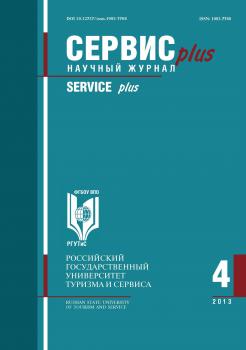Kemerovo, Russian Federation
The article is devoted to the creation of one of the main elements of the tourist destination marketing– tourist information center (TIC). In countries with high tourism development the TICs are integral to the promotion of each destination, in Russia at the moment there are only a few dozens. The authors point out main problems of creation and development of the TIC in Russia: harmonization of interests of founders, funding, functions. They are solved differently, depending on how they create the InfoCenter, which can be state or municipal institution, private profit organization, a public non-profit corporate structure or instrument of the Association of tourism enterprises. However, in specific domestic situations with limited development of the tourism market may the University may become the initiator and main driving force of TIC. The article discusses the unique successful experience of authors on creation of the particles on the basis of the University – the Tourist information centre of Kemerovo region on the basis of Kemerovo State University. It was created as a result of the interaction between structures of education, government, business, and business in the framework of the projects «Tempus» «Network of regional centers for tourism». The participants of the project (Kemerovo State University, Department of youth policy and sports of administration of the Kemerovo region and the Kuzbass Association of tourism industry) fonded the Regional resource centre of the tourism industry on the base of University. The resource center created and developed two important interrelated projects: «Tourist information centre of Kemerovo region» and «Strategy of development of tourist-recreational cluster of Kuzbass for the period up to 2025».
tourist information center, destination, tourism marketing
1. Anan´eva T.N., Ilyukhina G.I., Kir´yanova L.G., Yumatov K.V. Sotsial´no-partnerskoe vzaimodeystvie institutsional´nykh struktur pri podgotovke kadrov dlya turistskoy industrii . Vestnik Kemerovskogo gosudarstvennogo universiteta. T. 7. 2015. No 2 (62). S. 47-53.
2. Kolodiy N.A. Kul´tura kak resurs ekonomiki oshchushcheniy . Vestnik Tomskogo gosudarstvennogo universiteta. Filosofiya. Sotsiologiya. Politologiya. 2011. No 4 (16). S. 94-102.
3. Morrison A. Marketing and Managing Tourism Destinations. Routledge, 2013. 598 p.
4. Kiriyanova L. Marketing and branding of tourism destination. Aalborg: Aalborg University, 2010. 268 p.
5. Edgell D., Swanson J. Tourism Policy and Planning Yesterday, today, and tomorrow. Routledge, 2013. 299 p.
6. Nikonova E.R., Churlyaev B.A. Arkhitekturnoe reshenie turistsko-informatsionnogo tsentra kak vozmozhnost´ prodvizheniya turistskoy navigatsii po Penze i Penzenskoy oblasti. Perspektivy nauki i obrazovaniya. 2014. No 5(11). S. 145-151.
7. Putrik Yu.S. Osnovnye etapy formirovaniya i razvitiya turistskoy politiki v RF v 1992-2012 gg.. Sovremennye problemy servisa i turizma. 2012. No 2. S. 60-67.
8. Maevskiy D., Kulagina E., Proncheva O. Analiz perspektiv razvitiya turizma v sub´´ektakh Sibirskogo federal´nogo okruga. Uchenye zapiski universiteta im. P.F. Lesgafta. 2014. No 8 (114). S. 107-113.
9. Korchagina N.A. Osobennosti realizatsii klasternykh initsiativ v turizme. Vestnik Astrakhanskogo gosudarstvennogo tekhnicheskogo universiteta. Seriya: Ekonomika. 2010. No 1. S. 131-138.
10. Shatalov G. O roli turistsko-informatsionnykh tsentrov v razvitii turizma. Natsional´nyy turisticheskiy portal Rossii. URL: http://www.russiajourney.ru/2015/o-roli-turistsko-informacionnyhcentrov-v-razvitii-turizma (data obrashcheniya: 23.04.2015).
11. Akimova O.S. Logisticheskiy menedzhment v deyatel´nosti turistskogo informatsionnogo tsentra. Vestnik Saratovskogo gosudarstvennogo tekhnicheskogo universiteta. 2007. No 28. S. 161-166.
12. Ogneva V.A. Organizatsiya raboty turistskikh informatsionnykh tsentrov: opyt Zapada. Al´manakh sovremennoy nauki i obrazovaniya. 2011. No 11 (54). S. 147-148.
13. Gerashchenko L.I., Ryzhkova I.V. Mezhdunarodnaya proektnaya deyatel´nost´ sovremennogo universiteta kak faktor razvitiya regional´nogo turizma. Prostranstvo i vremya. 2013. No 3 (13). S. 79-85.
14. Kolodiy N.A., Egorova N.N., Zelenin A.A., Yumatov K.V. Resursnye tsentry industrii turizma: kontseptual´nye modeli i real´nost´. Vestnik Kemerovskogo gosudarstvennogo universiteta. T. 1. 2013. No 3 (55). S. 42-46.
15. Baev O.V., Makarov A.P., Mit´ A.A., Yumatov K.V. Razvitie turizma v Kuzbasse: novye napravleniya reindustrializatsii. Rossiyskie regiony: vzglyad v budushchee. 2015. No 3 (4). S. 67-81.
16. Davidson R., Keup M. The Use of Web 2.0 as a Marketing Tool by European Convention Bureaux . Scandinavian Journal of Hospitality and Tourism. 2014. Volume 14, Issue 3. P. 234-254.
17. Roque V., Raposo R. Social media as a communication and marketing tool in tourism: an analysis of online activities from international key player DMO. Anatolia. 2016. Volume 27, Issue 1. P. 58-70.
18. Trofimov E.N. Sotsial´nyy turizm v Rossii i Evrope. Vestnik RMAT. 2014. No 3. S. 3-10.
19. Taheri B., Jafari A., O’Gorman K. Keeping your audience: Presenting a visitor engagement scale. Tourism Management. 2014. Volume 42. P. 321-329.
20. Silva C, Kastenholz E., Abrantes J.L. Place-attachment, destination image and impacts of tourism in mountain destinations. Anatolia. 2013. Volume 24, Issue 1. P. 17-29.

















